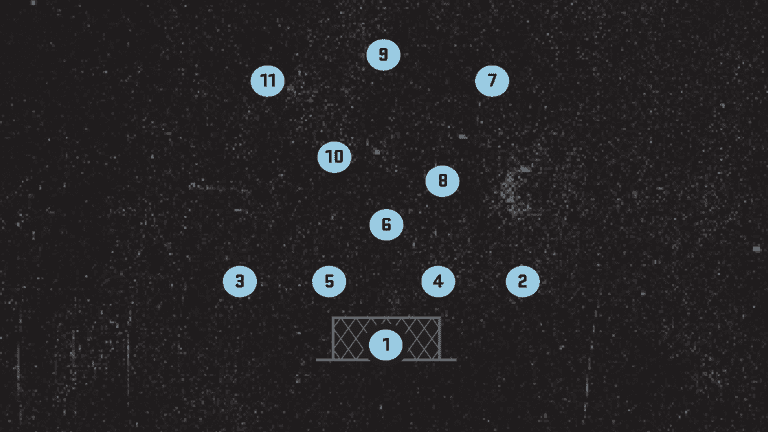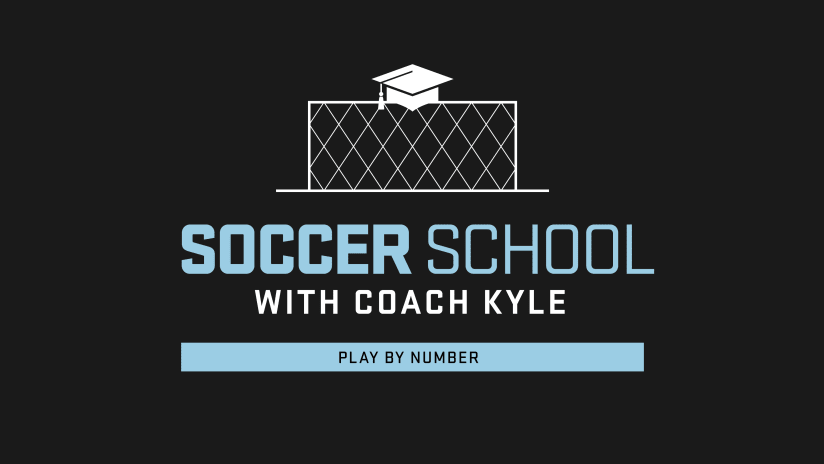Hey everybody, remember me? The people’s gaffer is back. I’ve been around all along, coaching my U11 team and continuing the youth soccer revolution here in Minnesota, but my boss wanted me to take a quick break from these lessons to make sure I understood that I’m not ACTUALLY Minnesota United’s coach. At least, not yet.
I must have done a good job of convincing him that I get the picture, because I’ve been greenlit for a return to full-blown, in-your-face (respectfully, of course), first-person action. It’s time to take the blinders off and run a little wild; oh, how I’ve missed this. Our first lesson back is all about numbers, but don’t worry, there’s little to no math involved.
Position by Number
If you’ve watched a soccer broadcast or consumed enough soccer media, you’ve probably heard players referred to as numbers rather than their positions or names. Oftentimes, these numbers don’t even match the numerals on their backs, which must surely seem like a terrible mistake from whomever you’re listening to. While we all make mistakes, I’d reckon you’ve stumbled upon something a bit different in this case.
Across the pitch, there are 11 traditional roles that players fill. Obviously, different formations utilize players in different ways, but the foundational concepts that these 11 roles represent effectively cover any position in whatever formation you cook up. It just so happens that the 11 roles come together to make a 4-3-3, so for explanatory purposes, we’ll be making comparisons to the Loons players that fit each role best. I’m using the graphic below as a reference point for the rest of the article, so take a good look:

First Five
Let’s start at the very beginning; a very good place to start. When you read, you begin with A-B-C, but when you sing… sorry, wrong analogy. If you need music tips, ask Julie Andrews. No, we’ll start with the number 1 position. That’s your goalkeeper, whose basic job is to keep the ball out of their net and redistribute possession when the game makes it all the way back there. For the Loons, that’s none other than Dayne St. Clair and, not to brag, he’s among the best in the league at what he does. If you want to learn how to play keeper, I’d watch him before you listen to me.
Next, we’ve got the 2 and 3 spots. Call them fullbacks, outside backs, or just plain tired, these guys are the unsung heroes of the game. We tend to use number 2 for the right and 3 for the left, but these positions are just mirrors of one another. The likes of Joseph Rosales, DJ Taylor, and (sometimes) Devin Padelford operate in these roles, protecting the flanks and trying to add a dimension to the attack with runs down the sideline. While it’s often a thankless job, the role of fullbacks can’t be understated when you’re trying to build an effective team.
Numbers 4 and 5 represent your right and left center backs, respectively. Miguel Tapias would be MNUFC’s first-choice 5, while Boxy occupies the 4 spot. Center back is a job easier to explain than it is to execute: don’t let the opposition find space in dangerous areas. These guys do a lot of one-on-one defending, as well as a significant amount of communicating with their team to organize the collective defensive shape.
Midfield
Now we’re getting to the fun stuff. In the midfield, positions are less cut-and-dried than anywhere else on the pitch. There’s no sideline to give you structure, and without some general guidelines, it can be easy to get lost in the action swirling around you. That’s why we’ve got the 6, 8, and 10 positions: to divvy up responsibility and make sure that everyone knows what they’re doing.
At the base of the midfield triangle, we’ve got our number 6, commonly known as a defensive midfielder. I’m talking about Wil freaking Trapp, baby, the legend himself. The 6 is a ball-winner, defense-shielder, and transition master. They’re the facilitators that keep everything from falling apart, plugging holes and doing the dirty work that needs done. They tend to hang back a bit, sweeping from side to side to protect the back line and keep the game in front of them.
At the other end of the midfield spectrum, we have the number 10. The gloriously tricky, endlessly entertaining, ever romanticized number 10 position that everyone loves. They’re the flashy quarterback, the creative spark that turns up the beauty of the game by a factor of, let’s say, ten, and they’re the reason that so many people have fallen in love with this sport. Loons fans have seen Robin Lod deputize in this role to start 2024, bringing his own uniquely effective approach.
Number 10s sit higher up the pitch, just behind the striker, and, depending on the player, are rarely asked to come back very far for defensive duties. This role is intentionally ambiguous, often allowing full creative freedom to let talented players express themselves uniquely as they try to unlock defenses with fancy footwork and visionary passing. Everyone plays it a little differently, but the objective remains the same: connect your team and create chances.
I saved the 8 for last because that’s where you put the best, right? The box-to-box midfielder is a jack of all trades and probably in the best shape on the whole team. Think about Alejandro Bran and Hassani Dotson; those guys put in a SHIFT every time they’re on the pitch. The number 8 is tasked with filling gaps, contributing to the attack, and connecting the team as needed. Essentially, they do everything that the 6 and 10 do, just to a lesser degree. In many ways, they lighten the load on their specialized counterparts, serving as the engine of any team.
Front Three, but Not Number Three
Onward to the forwards we go. There are just three numbers left; do you remember which ones they are? Well done. 7, 9, and 11. Why did we go out of order with the midfield? When the number system was originally devised in the 1920s, tactics were a bit different, with a 2-3-5 system dominating the day. When the 4-4-2 and 4-3-3 came into the limelight, adjustments were made, and they’ve remained ever since.
On the left wing, we’ve got our number 11, while the right winger claims the number 7. Like fullbacks, these players are meant to give their team width, stretching the field and using a mixture of athleticism and passing to create chances from wide areas. Bongi and Sang Bin do a great job in these roles, even demonstrating a willingness to get back and assist their fullbacks in their defensive duties.
Finally, the number nine. While the position can be played in different ways, we tend to think of a number 9 as a traditional striker, goal scorer, and threatening presence in the opponent’s box. Teemu Pukki plays this role to a tee; watching him play will always be better than any explanation I manage to put on paper.
Wait, What?
So why do we tend to use some numbers more than others in conversation? I’m so glad you asked. Honestly, it’s just a matter of preference, but I’ll try to break it down a bit more. If you’re trying to understand a position, the first thing you should determine is which area on the field you’re looking at: defense, midfield, or forward. From there, some roles are more cut-and-dried than others.
For example, if we’re talking about a center back, the role itself doesn’t change much whether you’re on the right, left, or in the middle of a back three. So, we tend to simply refer to center backs by their title and position relative to their partner(s). Likewise, if we’re talking about a fullback, the main differentiator is the side of the pitch they play on; thus, we add right or left to the name.
Forward positions work fairly similarly, with references to wingers following the same pattern as fullbacks. Strikers are commonly referred to as number 9s as a quick way to explain that they play centrally, but the two terms are interchangeable.
When we get to the midfield, though, you can see where you could run into problems by simply calling someone a center mid. What are they doing there? How do they work with their teammates? Why are there three people doing the same thing? So, to avoid confusion, we tend to use the numerical position title in these areas. Sure, we could just say attacking midfielder, defensive midfielder, or box-to-box midfielder, but that’s lame and easier to understand. Numbers are more fun, more confusing, and, honestly, just a lot cooler than words.
It’s one of those things that’s hard to understand until it’s explained to you, because the numbering is pretty arbitrary and takes some context to get your head around. But that’s why I’m here. To impart my knowledge, coach you through it, and raise my voice when you don’t get it right on your first try.
Just kidding; I’m not much of a yeller. Just do your best and try it out. Maybe you’ll impress some people at your next watch party when you break the players down by numerical position. Or, maybe you’ll just confuse everyone. Either way, make sure you plug my articles so I can share more soccer tips for years to come.




